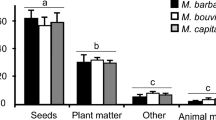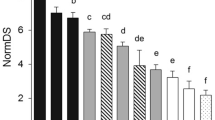Abstract
Ants of the genus Pheidole are important seed consumers in several desert ecosystems. In South American deserts, although several Pheidole spp. have been characterized as seed harvesters, studies on their diet and ecological role are still missing. Pheidole spininodis (Mayr) and Pheidole bergi (Mayr) are capable of removing seeds in the central Monte desert. The aim of this study was to quantify and compare the diet of these species and to interpret the results in the context of seed–granivore interactions. Diet was estimated during mid-summer by collecting items brought back to the nest by foragers in ten colonies per species. While P. spininodis was mainly granivorous, P. bergi was mainly insectivorous. However, they both collected ~40% of other types of items. Among seeds, the diet of P. spininodis included mostly grass seeds, whereas the diet of P. bergi was mainly made up of shrub and tree seeds, usually retrieved cooperatively. This behavior allowed P. bergi to carry larger seeds, resulting in diet partitioning in terms of seed size. However, diet of P. spininodis is very similar to that of three sympatric Pogonomyrmex species. Thus, specialized harvester ants remove large quantities of grass seeds in the central Monte desert during the summer, potentially affecting their abundance in the soil seed bank. P. bergi directs its feeding pressure to shrub and tree seeds, and although seeds constitute ~10% of its diet, its high colony density and high activity levels, added to the lower proportion of large seeds in the soil seed bank, indicate that their importance as seed consumers cannot be ruled out.





Similar content being viewed by others
References
Andersen A.N., Azcárate F.M. and Cowie I.D. 2000. Seed selection by an exceptionally rich community of harvester ants in the Australian seasonal tropics. J. Anim. Ecol. 69: 975–984.
Brown J.H., Reichman O.J. and Davidson D.W. 1979. Granivory in desert ecosystems. Annu. Rev. Ecol. Syst. 10: 201–227.
Cerdá X., Retana J. and Cros S. 1998. Prey size reverses the outcome of interference interactions of scavenger ants. Oikos 82: 99–110.
Crist T.O. and MacMahon J.A. 1992 Harvester ant foraging and shrub-steppe seeds: interactions of seed resources and seed use. Ecology 73: 1768–1779.
Davidson D.W. 1977. Species diversity and community organization in desert seed-eating ants. Ecology 58: 711–724.
Espigares T. and López-Pintor A. 2005. Seed predation in a Mediterranean pasture: can ants modify the floristic composition of soil seed banks? Rev. Chil. Hist. Nat. 78: 615–622.
Franks N.R. 1986. Teams in social insects: group retrieval of prey by army ants (Eciton burchelli, Hymenoptera: Formicidae). Behav. Ecol. Sociobiol. 18: 425–29.
Gotelli N. J. and Entsminger G. L. 2001 EcoSim: Null Models Software for Ecology, version 7.0. Acquired Intelligence Inc. & Kesey-Bear, Burlington, VT.
Gross C.L., Whalen M.A. and Andrew M.H. 1991. Seed selection and removal by ants in tropical savanna woodland in Northern Australia. J. Trop. Ecol. 7: 99-112.
Hölldobler B. and Wilson E.O. 1990. The Ants. Harvard University Press, Cambridge. 732 pp.
Hölldobler B., Stanton R.C. and Markl H. 1978. Recruitment and food-retrieving behavior in Novomessor (Formicidae: Hymenoptera). I. Chemical signals. Behav. Ecol. Sociobiol. 4: 163–81.
Inouye R.S., Byers G. and Brown J.H. 1980. Effects of predation and competition on survivorship, fecundity, and community structure of desert annuals. Ecology 61: 1344–1351.
Judd T.M. 2006. Relationship between food stores and foraging behavior of Pheidole ceres (Hymenoptera: Formicidae). Ann. Entomol. Soc. Am. 99: 398–406.
Kusnezov N. 1951. El género Pheidole en la Argentina (Hymenoptera, Formicidae). Acta Zool. Lilloana 12: 5–88.
Lopez de Casenave J., Cueto V.R. and Marone L. 1998. Granivory in the Monte desert: is it less intense than in other arid zones of the world? Global Ecol. Biogeogr. Lett. 7: 197–204.
MacMahon J.A., Mull J.F. and Crist T.O. 2000. Harvester ants (Pogonomyrmex spp.): their community and ecosystem influences. Annu. Rev. Ecol and Syst. 31: 265–291.
Marone L. and Horno M.E. 1997. Seed reserves in the central Monte Desert, Argentina: implications for granivory. J. Arid Environ. 36: 661–670.
Marone L., Lopez de Casenave J. and Cueto V.R. 2000. Granivory in southern South American deserts: conceptual issues and current evidence. BioScience 50: 123-132.
Milesi F. and Lopez de Casenave J. 2004. Unexpected relationships and valuable mistakes: non-myrmecochorous Prosopis dispersed by messy leafcutting ants in harvesting their seeds. Austral Ecol. 29: 558-567.
Peralta I.E. and Rossi B.E. 1997. Guía para el reconocimiento de especies del banco de semillas de la Reserva de la Biósfera de Ñacuñán (Mendoza, Argentina). Bol. Ext. Cient. IADIZA 3: 1-24.
Pfeiffer M., Nais J. and Linsenmair K.E. 2006. Worker size and seed size selection in ‘seed’-collecting ant ensembles (Hymenoptera: Formicidae) in primary rain forests on Borneo. J. Trop. Ecol. 22: 685–693.
Pirk G.I. 2007. Granivoría por hormigas del género Pogonomyrmex en el Monte central: consumo de semillas e impacto sobre el banco de suelo. Ph.D. thesis. Universidad de Buenos Aires, Buenos Aires, Argentina.
Pirk G.I. and Lopez de Casenave J. 2006. Diet and seed removal rates by the harvester ants Pogonomyrmex rastratus and Pogonomyrmex pronotalis in the central Monte desert, Argentina. Insect. Soc. 53: 119-125.
Pirk G.I., Lopez de Casenave J. and Pol R. 2004. Asociación de las hormigas granívoras Pogonomyrmex pronotalis, P. rastratus y P. inermis con caminos en el Monte central. Ecol. Austral 14: 65–76.
Pirk G.I., Lopez de Casenave J., Pol R., Marone L. and Milesi F. (in press). Influence of temporal fluctuations in seed abundance on the diet of harvester ants (Pogonomyrmex spp.) in the central Monte desert, Argentina. Austral Ecol.
Pol R.G. 2008. Granivoría por hormigas del género Pogonomyrmex en el Monte central: respuestas funcionales a las variaciones en la disponibilidad de semillas Ph.D. thesis. Universidad Nacional de Cuyo, Mendoza, Argentina.
Pulliam H.R. and Brand M.R. 1975. The production and utilization of seeds in plains grassland of southeastern Arizona. Ecology 56: 1158–1166.
Reichman O.J. 1979. Desert granivore foraging and its impact on seed densities and distributions. Ecology 60: 1085–1092.
Rice W.R. 1989. Analyzing tables of statistical tests. Evolution 43: 223–225.
Robson S.K. and Traniello J.F.A. 2002. Transient division of labor and behavioral specialization in the ant Formica schaufussi. Naturwissenschaften 89: 128–131.
Samson D.A., Philippi T.E. and Davidson D.W. 1992. Granivory and competition as determinants of annual plant diversity in the Chihuahuan desert. Oikos 64: 61–80.
Taber S.W. 1998. The World of the Harvester Ants. Texas A & M University Press, College Station. 213 pp.
Traniello J.F.A. 1983. Social organization and foraging success in Lasius neoniger (Hymenoptera: Formicidae): behavioral and ecological aspects of recruitment communication. Oecologia 59: 94–100.
Traniello J.F.A. 1989. Foraging strategies of ants. Annu Rev. Entomol. 34: 191–210.
Whitford W.G. 1978. Foraging in seed harvester ants Pogonomyrmex spp. Ecology 59: 185–189.
Whitford W.G., Depree D.J., Hamilton P. and Ettershank G. 1981. Foraging ecology of seed-harvesting ants, Pheidole spp. in a Chihuahuan desert ecosystem. Am. Midl. Nat. 105: 159–167.
Wilson E.O. 2003. Pheidole in the New World: A Dominant, Hyperdiverse Ant Genus. Harvard University Press, Cambridge. 794 pp.
Acknowledgments
We thank Paula Fergnani for critical comments on previous versions of the manuscript and for her valuable help. Financial support was supplied by CONICET, ANPCyT of Argentina, ultimately through PICT 01-12199, and Universidad de Buenos Aires, ultimately through UBACyT X/120. This is contribution number 64 of the Desert Community Ecology Research Team (Ecodes) of IADIZA Institute (CONICET) and FCEyN (Universidad de Buenos Aires).
Author information
Authors and Affiliations
Corresponding author
Rights and permissions
About this article
Cite this article
Pirk, G.I., di Pasquo, F. & Lopez de Casenave, J. Diet of two sympatric Pheidole spp. ants in the central Monte desert: implications for seed–granivore interactions. Insect. Soc. 56, 277–283 (2009). https://doi.org/10.1007/s00040-009-0021-5
Received:
Revised:
Accepted:
Published:
Issue Date:
DOI: https://doi.org/10.1007/s00040-009-0021-5




